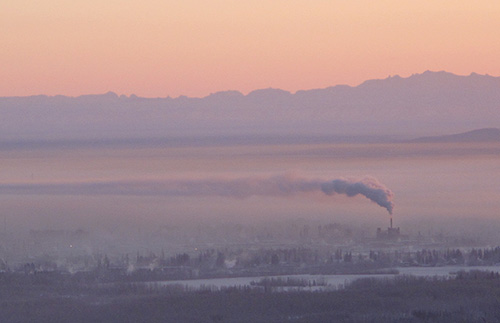
A cool idea for locking up carbon dioxideBy NED ROZELL
October 25, 2014
In December, the UAF geologist/volcanologist will tack a poster in a San Francisco meeting hall amid the crashing surf of a thousand conversations. To educated passersby at the fall meeting of the American Geophysical Union, he will explain his idea of capturing a greenhouse gas and raining it out over the coldest place on Earth.
Carbon dioxide emissions, like these from a Fairbanks coal-burning plant, have accelerated worldwide in the recent past.
Beget's idea is an example of geoengineering: using manmade solutions to reduce carbon dioxide levels in the 30-mile shell of gases around Earth. Accelerating levels of greenhouse gases in our atmosphere are a frequent topic at the conference. Al Gore and climate scientist James Hansen have spoken with urgency on the subject in lecture halls packed with more people than live in most Alaska towns. With geoengineering, humans attempt to modify the effects of planet-warming molecules in the atmosphere. These ideas, most still in the think-tank stage, range from painting roofs white to reflect sunlight to seeding the atmosphere with volcanic-emission-like particles known to cause global cooling. Another way to tackle the problem is to suck carbon dioxide from the atmosphere. Some have suggested dumping iron filings in the ocean to stimulate the growth of CO2-consuming plankton. As he pondered these notions, Beget's northern bias came through. "There really hasn't been any suggestion of using the cryosphere (the frozen parts of the planet) to store CO2," he said. He thought the great plateau of East Antarctica, home of the South Pole. There sits an ice sheet as large as the Lower 48. At its thickest, the ice is 15,000 feet above the ocean. Upon that ice in 1983, Russians at the Vostok Research Station recorded a temperature of minus 128.6 Fahrenheit. Ice cores show no evidence of temperatures close to the thawing mark. "There's no melt in the record, which goes back 200,000 years," Beget said. "It's a natural place for this concept." To get the carbon dioxide out of the air and down to the ice sheet, Beget proposes seeding the air over central Antarctica with monoethanolamine, a compound industry workers use to capture carbon dioxide before it exits smokestacks. Snowfalls would bury the crystals infused with carbon dioxide until the high-altitude parts of the ice sheet touch the sea or otherwise thaw. That would buy some time, Beget said. "According to the physics and ice-flow models, you have a couple hundred thousand years." Beget admits that both the manufacture of monoethanolamine and the transport of it to Antarctica are carbon-emitting activities, but he says other compounds with less of a footprint might be substituted. He knows that executing a perfect solution to excess carbon dioxide is not realistic. The quiet, thoughtful professor is striding into a contentious arena because has not before heard anyone suggest Earth's freezer as a place to store CO2. And because it's time. "Frankly, I'm worried about global warming. I'm worried about climate change. I'd like to suggest something that might help.”
|
||
